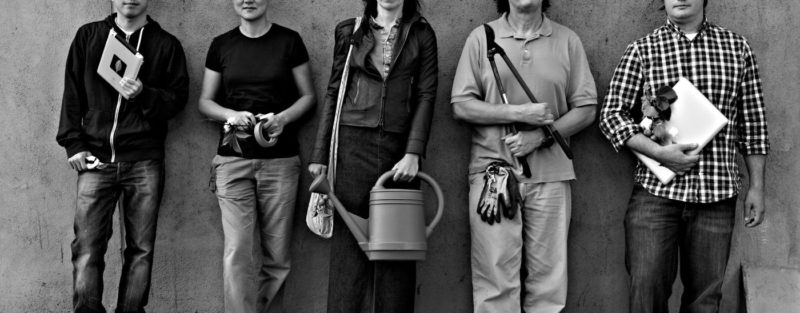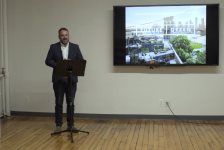An interesting phenomena happens when urban trees suddenly start dropping fruit–people and the communities come together to feast on the spoils!
Recently, the Slow Food Movement hosted a group of accomplished professionals in an engaging discussion on local food sources and accessible edible landscapes. The San Francisco-based organization Guerrilla Grafters joined the conversation to discuss solutions to combat “food deserts,” areas of high food insecurity. Per their name, the group illegally grafts fruiting limbs onto existing street trees to provide communities with access to fresh fruit.
Guerrilla Grafiting takes its roots from Guerrilla Gardening, a practice with a long history that dates back to the 17th century. In the 1960s and 70s. a bicoastal resurgence took hold of the movement in the United States–hippies on the west coast and hipsters on the east coast. The movement gained in popularity when in 2004, Richard Reynolds–considered the father of Modern Guerrilla Gardening–began documenting and spreading the gospel of “illicit cultivation” on his blog. Guided by the mission to tackle “the war against neglect and scarcity of public space as a place to grow things,” Reynolds moved around London, steadily grafting his way towards a tastier paradise.
Though the underlying motivations for Guerrilla Gardening and Grafting are similar, the former group primarily aims to beautify neglected space, whereas the latter grafts to turn established sterile trees into fruiting trees in order to maximize the benefit of those plants.
 Tara Hui, founder of Guerrilla Grafters explains the inspiration behind her project: “we really didn’t have any fresh produce. The area I lived in was considered a food desert, but it had a lot of sidewalks.” The purpose of the Grafters, she explains, “is not so much to antagonize but to bolster a sense of ownership within the community.” Hui stresses that the group doesn’t haphazardly graft; each grafted tree has an “adoptive parent” who monitors the progress of the graft and the overall health of the tree as it morphs into abundance. Grafting also provides social opportunities, such as “a sense of camaraderie and relationship with neighbors and a trusting relationship with the space and people around you.”
Tara Hui, founder of Guerrilla Grafters explains the inspiration behind her project: “we really didn’t have any fresh produce. The area I lived in was considered a food desert, but it had a lot of sidewalks.” The purpose of the Grafters, she explains, “is not so much to antagonize but to bolster a sense of ownership within the community.” Hui stresses that the group doesn’t haphazardly graft; each grafted tree has an “adoptive parent” who monitors the progress of the graft and the overall health of the tree as it morphs into abundance. Grafting also provides social opportunities, such as “a sense of camaraderie and relationship with neighbors and a trusting relationship with the space and people around you.”
The grafting season occurs in late winter or early spring, when the trees are just beginning to wake up from dormancy. In the meantime, Guerrilla Grafters encourage activists to set up grassroots guerrilla grafting groups. Their hope is that people will take ownership of different geographical regions and use grafting to enhance their communities through food and social awareness.
The San Francisco-based Guerrilla Grafters also offer an online, open-source database to help grafters locate graftable trees, track progress of existing trees, add newly grafted trees, and facilitate ripe fruit foraging. As grafts occur, they are added to the database, monitored, and observed for progress, health, and fruit production.
The group also tracks their grafts for vandalism. “We say ‘vandals’ although we suspect some sort of authority or agency, but we can’t prove it,” says Hui. “The targeting and skill of pruning [can be] so severe…that we don’t think it’s just random people doing [the vandalism]. In one case in San Francisco, an entire street of trees were pruned/had grafted branches cut off, and some have died as a result.” In order to preserve their work, the group must be careful to not release photos that depict identifying landmarks. Recently, the group has abandoned the use of flashy, color-coded electrical tape in favor of the more discrete grafting tape.
 Interestingly, some of their greatest support comes from computer hackers–who help identify weaknesses in city mandates–and artists who appreciate the work as garden graffiti. Many municipalities, however, oppose guerrilla grafting on the grounds of public safety, should someone slip on the sidewalk from rotting fruit, as well as fears of other nuisances such as rat infestations.
Interestingly, some of their greatest support comes from computer hackers–who help identify weaknesses in city mandates–and artists who appreciate the work as garden graffiti. Many municipalities, however, oppose guerrilla grafting on the grounds of public safety, should someone slip on the sidewalk from rotting fruit, as well as fears of other nuisances such as rat infestations.
I believe the art of the Guerrilla Grafters and its tagline–“Unraveling civilization one branch at a time”–is a brilliant example of “constructive rebellion” and definitely one to keep your eye on!
Do you live in a food desert or have advocates participating in unlawful, radical forms of propagation in your community? Comment down below to let us know!
All Images courtesy of Guerrilla Grafters.
Published in Blog








![Beyond Our Landscapes: Interdisciplinary Research and Design for Health [Video]](https://land8.com/wp-content/uploads/2018/02/coco-alarcon-224x150.png)
